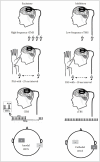Non-Invasive Brain Stimulation for Treatment of Focal Hand Dystonia: Update and Future Direction
- PMID: 27240806
- PMCID: PMC4886207
- DOI: 10.14802/jmd.16014
Non-Invasive Brain Stimulation for Treatment of Focal Hand Dystonia: Update and Future Direction
Abstract
Focal hand dystonia (FHD) is characterized by excessive and unwanted muscle activation in both the hand and arm resulting in impaired performance in particular tasks. Understanding the pathophysiology of FHD has progressed significantly for several decades and this has led to consideration of other potential therapies such as non-invasive brain stimulation (NIBS). A number of studies have been conducted to develop new therapy for FHD using transcranial magnetic stimulation and transcranial direct current stimulation. In this paper, we review previous studies and describe the potential therapeutic use of NIBS for FHD. We also discuss the future direction of NIBS to treat FHD.
Keywords: Focal hand dystonia; Non-invasive brain stimulation; Transcranial direct current stimulation; Transcranial magnetic stimulation.
Conflict of interest statement
The authors have no financial conflicts of interest.
Figures

References
-
- Hunter D. The diseases of occupations. 6th ed. London: Hodder and Stoughton; 1978.
-
- Lungu C, Ahmad OF. Update on the use of botulinum toxin therapy for focal and task-specific dystonias. Semin Neurol. 2016;36:41–46. - PubMed
Publication types
LinkOut - more resources
Full Text Sources
Other Literature Sources

